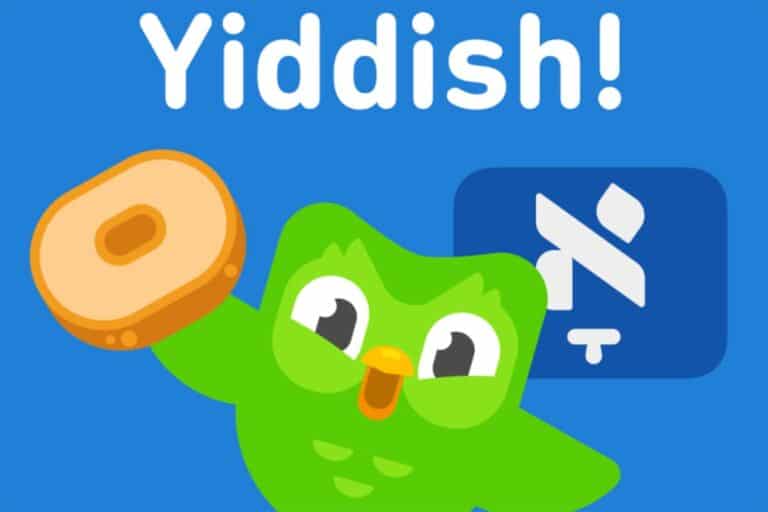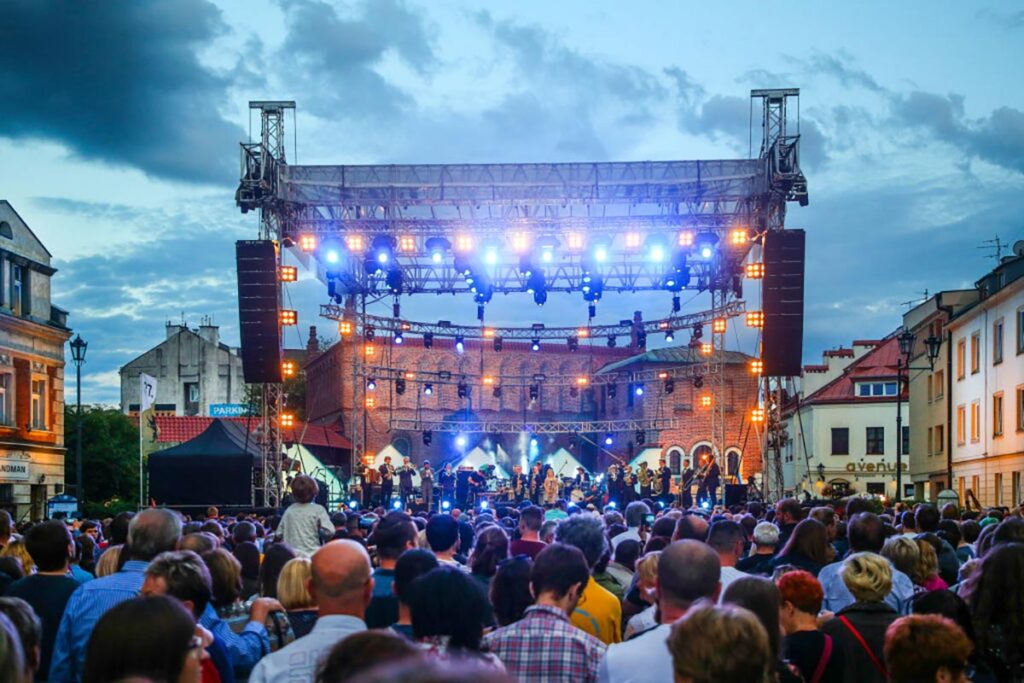
Yiddish, the thousand year-old language of Ashkenazi Jews based on medieval German, Hebrew, Aramaic and Slavic languages, could have easily been a dead spoken language by now.
From a peak of more than 10 million speakers before World War II — including a full cultural life of newspapers, literature, music and theater — it took massive blows from a variety of forces before experiencing a resurgence in recent years.
@shvesters Chiribim, Chiribom! #jewish #jazz #yiddish
♬ original sound – The Shvesters
For example, consider the sold-out off-Broadway runs of “Fiddler on the Roof” in Yiddish (“Fidler afn dakh”), a quarter of a million downloads of the Yiddish Duolingo course, and the emergence of popular Yiddish TikTokers.
Why is all of this happening? Here are four reasons why Yiddish is making a comeback, but first, let’s briefly explore the history of Yiddish and who speaks it today.
Yiddish: A brief history
Yiddish (which simply means “Jewish”) began in the 10th century as the Jewish community in northern Italy made their way to the German Rhine Valley.
@forverts The Forward got a special visitor. @Alex Edelman #yiddish
♬ original sound – פֿאָרװערטס
These Jews became known as Ashkenazim, using a Biblical name for the place we call Germany today. They interacted with their neighbors, eventually creating a Jewish-German language written in Hebrew characters, incorporating German, Hebrew and Aramaic.
The language evolved in the 14th to 17th centuries, as many Ashkenazi Jews migrated east to the Pale of Settlement (an area stretching from Latvia to Ukraine) and incorporated Slavic elements, adding words from Russian, Polish and Ukrainian.
In the mid-19th century, Yiddish culture began to emerge as part of the Haskalah (Jewish Enlightenment period). Sholem Aleichem’s series of short stories, “Tevye der milkhiker” (Tevye the Dairyman), became the basis for Fiddler on the Roof, for example.
Plays reverberated through local theaters; you might be familiar with “The Dybbuk,” a play by S. An-sky about a woman possessed by a dybbuk (evil spirit).
Yiddish also became the language of Jewish political movements in Eastern Europe — Revisionist Zionist leader Ze’ev (Vladimir) Jabotinsky made the first filmed political speech in Yiddish in 1934, passionately decrying Britain’s quota system limiting Jewish immigration to Mandatory Palestine.
Its reach and power spread far beyond Eastern Europe as Jews immigrated around the world and lived their lives in the language.
But the growth of Yiddish was abruptly put to a halt during World War II.
Most of the six million Jews murdered in the Holocaust were Yiddish speakers. When those who survived tried to settle back in Poland, Lithuania and other Eastern European countries, they were confronted with a hostile antisemitic environment, and most left soon after.
With their deaths and the near-annihilation of Jewish life in Eastern Europe, it became difficult to revitalize the language.
In the former Soviet Union, Josef Stalin had relied upon a committee of Yiddish-speaking intellectuals called the Jewish Anti-Fascist Committee to raise support and money for the Soviet war effort against the Nazis.
However, at the end of the war, Stalin perceived most of the committee members as too much of a threat to his power and ordered their execution. This led to shut-downs of Soviet Yiddish institutions and a general suppression of Jewish culture and religion.
Meanwhile, in the United States, Jews distanced themselves from Yiddish in an effort to assimilate and gain economic opportunities, as well as to avoid being seen as communists with the onset of the Cold War.
In Israel, Prime Minister David Ben-Gurion and the government viewed Yiddish as the language of a diaspora past they sought to move beyond.
Despite Ben-Gurion and many other early Zionist leaders being native Yiddish speakers themselves, they saw the revival of Hebrew as key to unifying the new Jewish state and prioritized its use.
As a result, measures that limited the use of Yiddish, such as aggressive disruptions of Yiddish events and attempts to limit Yiddish publications, contributed to a significant decline of the language in Israel.
Ben-Gurion’s discomfort with Yiddish was so profound that he once stated — in Hebrew — that the language spoken by a Holocaust survivor “grates on my ears.”
“The assumption prevailing in Israel [after] the end of the war was that the Yishuv [Jewish community in Palestine] respected only those who took up arms; [the Jews of the Diaspora] were considered inferior human beings who went ‘like lambs to the slaughter,’” Israeli historian Dina Porat explained.
Only a handful of Hasidic groups, largely from Hungary and Romania, held onto the language. After the Holocaust, Hasidic survivors settled in small communities around the world, intentionally isolating themselves to preserve their way of life and language.
So, where does that leave us today? It’s estimated that there are currently less than 1 million Yiddish speakers in the world, the majority located in the U.S. and Israel. They are mostly Hasidim, but also include people whose parents or grandparents spoke Yiddish with them, and those learning it for the first time.
Only in the last few years have we seen a renewed interest in Yiddish. “A growing number of young Jews are reconsidering — or considering for the first time — the meaning of the Ashkenazic Jewish heritage as an important part of contemporary Jewish identity,” Neil Zagorin, bibliographer at The Yiddish Book Center in Amherst, Mass., explained.
Why this is happening is a simple question with four different answers.
1. A new generation sees Yiddish in a fresh light.
For this one, we need to delve into a psychological theory, but stay with me. In 1938, Danish-American historian Marcus Lee Hansen formulated “the principle of third generation interest.”
@smithsonianchannel Learn about the importance of Yiddish for Jewish American Heritage Month from Cameron Bernstein, a student of the language. @Cameron Bernstein #JewishTikTok #JewishAmericanHeritageMonth
♬ original sound – Smithsonian Channel
His idea was that among immigrants, “what the son or daughter wishes to forget, the grandson or granddaughter wishes to remember.”
Applying this theory to the resurgence of Yiddish, it could be interpreted as follows: The generation of Jewish immigrants and their children, in their quest to assimilate and be accepted as Americans, may have set aside their Yiddish language and traditions.
Yet, the grandchildren and great-grandchildren of these immigrants, born and raised as Americans with no sense of inferiority, find themselves yearning to reconnect with their cultural roots.
This phenomenon isn’t just about reclaiming language; it’s also about embracing a distinct cultural identity unburdened by the stigmas of the past.
For these American-born grandchildren and great-grandchildren, the focus has shifted from assimilation to the active pursuit of their Jewish heritage, manifesting in this renewed interest in, and embrace of, Yiddish.
2. There is a desire to connect with a “lost” heritage.
This brings us to the second reason for the recent interest in Yiddish: The Yiddish learner is often looking for a cultural identity or looking to strengthen an existing one.
One Yiddish learner, Laurie Fisher, wrote that when she began classes in 2020, she was willing to accept that her goal was not necessarily to become a fluent Yiddish speaker. “Rather, my goal is to learn more about my cultural heritage, and I felt reading and understanding Yiddish should be part of my toolbox,” she explained.
“There is a deep and profound hunger for knowledge of this history, culture and language,” said Jonathan Brent, director and CEO of the Yiddish language and culture organization YIVO. “What we are seeing is not simply nostalgia for a lost world but a repossession of it, and with that, a reassertion of a stubborn, proud, deeply held Jewish identity.”
As with Hebrew, learning Yiddish often extends beyond the desire to integrate into a specific community. This practice aligns with an idea put forth by Jeffrey Shandler, a Jewish Studies professor at Rutgers: people may learn Yiddish not for daily use, but as a potent symbol of their identity and heritage.
By learning Yiddish, individuals are connecting with a rich cultural history and making a public statement of Jewish identity and heritage.
3. Yiddish has historically been associated with progressive causes.
Yiddish, being at the margins of Jewish society for decades, was the cultural refuge of Jews who identified with the political far left, the LGBTQ community, and the feminist movement. The language’s historical association with such causes make it attractive to many young Jews today.
For example, Kaia Berman-Peters, the creator of “Kleztronica,” a genre that mixes electronic dance music and klezmer (Ashkenazi folk music), prominently features the history and present of social justice activism in Yiddish in her work.
In her song “Utzu Ietza,” Berman-Peters, 22, includes recordings of Yiddish-speaking artists and activists such as anarchist Emma Goldman, artist Jenny Romaine, actress Molly Picon and actor Mikhl Yashinsky, talking about topics like LGBTQ issues and the treatment of Palestinians.
The dance parties are growing as fast as the popularity of the messages in her music: one of Berman-Peters’ recent concerts drew over 500 people.
4. The proliferation of Yiddish resources on the internet make it easier to learn the language.
In the post-pandemic age of digital communication, the phrase “Yidish in ale lender” (Yiddish in every country) has taken on a new meaning. Yiddish, an internationally-spoken language, can now be learned from almost anywhere, thanks to a plethora of online resources.
Cultural institutions around the world — like YIVO, the Yiddish Book Center, YUNG YiDiSH in Tel Aviv, and Kadimah in Melbourne, Australia — have embraced the digital age and created online lessons and lectures, bringing Yiddish education to a global audience.
The Yiddish Book Center, for example, digitized a massive corpus of Yiddish literature and translated it into English, an effort generously sponsored by film director Steven Spielberg.
With the release of Duolingo’s Yiddish course in 2021, Yiddish lessons became even more accessible to the general public.
Plus, new speakers and enthusiasts have turned to social media, sharing what they are learning on platforms like TikTok, podcasts like “Vaybertaytsh,” and web series like YidLife Crisis.
In-person Yiddish events have also proliferated in recent years. Krakow, Poland, hosts the world’s largest Jewish cultural festival each year, which celebrates Yiddish culture specifically.

In the past, Yiddish institutions and clubs were geographically isolated from each other. Now, especially in the post-Covid world of remote learning, there are many more opportunities to engage with Yiddish online.
Conclusion
All of these converging factors — the desire to connect with one’s Jewish heritage and identity, the championing of progressive ideas and causes, and the availability of new resources and media content — have spurred the sudden popularity of Yiddish today.
It is difficult to predict whether this recent trend will continue to rise, or whether it is a movement for the moment. But, given the vibrant scene of Yiddish events happening today, it is hard to imagine that interest in Yiddish will diminish anytime soon.
The newfound popularity of Yiddish marks a profound reclaiming of Ashkenazi Jewish heritage that was overshadowed by assimilation and nearly destroyed in the Holocaust. With millions more Ashkenazi Jews to reach, this linguistic revival story is far from its final chapter.
Originally Published Jul 25, 2023 06:55PM EDT
